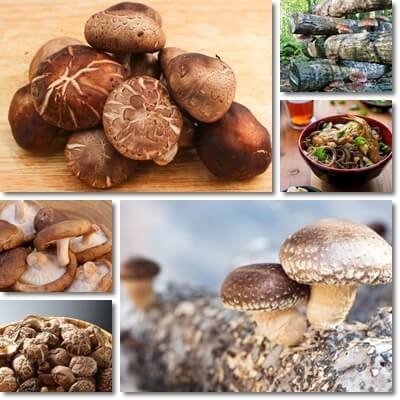Shiitake (scientific name: Lentinula edodes) are a variety of edible mushrooms with therapeutic potential and a good nutritional value. They are also known as oak or golden oak mushrooms, Chinese forest mushroom or Oriental black mushroom. They occur naturally across Eastern Asia where they grow on oak and other tree species, but are also extensively cultivated for commercial production.
The raw and especially dried mushrooms are excellent sources of vitamins B2, B3, B5 and B6, but also manganese, phosphorus and zinc. Shiitake are good for energy metabolism, boast cardiovascular benefits, antioxidant and immune system-modulating properties as well as support thyroid health, fertility and healthy weight loss.
What do shiitake mushrooms look like?
The species has a typical mushroom appearance in the sense that it has a rounded, umbrella-shaped cap which is supported by a well-defined stem, stalk or stipe.
The cap margins are curled under in younger mushrooms, but the cap flatten with time. Underneath the cap there are elongated gills of a white to light brown, sometimes tan or almost orangey-brown color.
The spore print is white. The cap is light to dark brown on top, with white speckles or irregular gashes that reveal a lean, white flesh. The white ‘cracks’ in the mushroom tops are a defining characteristic of shiitake. The stalk is white to light brown in color. Shiitake can be eaten raw, cooked and dried. They are also available in powder form and meant to be consumed as a nutritional supplement.

What do shiitake mushrooms taste like?
Shiitake mushrooms are sometimes said to taste terrible, but that’s not quite true. The fresh mushrooms have a mild taste at most and tend to absorb the stronger flavors of the foods they are cooked with. The dried ones are much more flavorful, but not overwhelming. The taste profile of cooked shiitake lists earthy, woodsy and smoky flavor notes with a sometimes bitter aftertaste.
The cap is soft, only slightly rubbery or fleshy, almost meaty in texture, while the stalk or stipe has a slightly tougher texture which is why a lot of people prefer to dry the stalks and make shiitake powder out of them. The dried mushrooms need to be soaked first – if they don’t get soaked enough, they stay rubbery or crunchy, depending on the choice of cooking method.
Tips for cooking shiitake
The best way to cook shiitake mushrooms is together with other ingredients. This allows the mushrooms to acquire the flavors of the other foods they are cooked with, while still imparting a pleasantly savory earthy aroma to the dish. Cooking and eating them by themselves can result in a different taste experience, not necessarily a good one. When cooked and eaten by themselves, shiitake can retain a sometimes bitter aftertaste, although the degree of bitterness is relative in the sense that it’s determined by individual taste perception. The bitter aftertaste is reported to be more perceivable in dried shiitake which need to be rehydrated before consumption. The raw mushroom can have a faint sour or musky odor, but again, smell perception is fairly individual.
Also, the stalks are often discarded and only the caps used, but this is a more personal preference as the entire mushroom – stalk and cap – is edible. Recipes in which to incorporate shiitake include: pasta, risotto, mushroom sauces for meat dishes or soups such as Japanese miso soup. Since the caps are between 5-10 cm in diameter, they are great for grilling and making vegetarian burgers. Finely sliced caps can be turned into chips or stir-fried and added to salads.
How to prepare dried shiitake mushrooms for cooking. First of all, get your shiitake from a reputable source, whether it’s your local supermarket, an Asian food market, ethnic or health food store. As they’re expensive, be prepared to pay a handsome price for them – price is also an indicator of quality. Expect to pay anywhere from 8-12 dollars for regular and 12-16 dollars for organic shiitake. If you choose to buy dried shiitake, make sure they are as fresh as possible. They store well for about a year, but it’s better to buy them well before they reach their expiration date. While they shouldn’t taste terrible, expect them to have a slight bitter aftertaste and maybe a certain odor to them, musky, possibly sour. For the best taste experience, incorporate them in more complex dishes. Lastly, rehydrating dried shiitake requires steeping them in hot water for 15 minutes to up to an hour. To help reduce bitterness, change the water at least once.

Can you eat shiitake raw?
Technically, shiitake can be eaten raw (fresh, uncooked), dried and cooked or consumed as a nutritional supplement in powder form. But although you can eat the mushrooms raw, it’s best you don’t. Raw and undercooked shiitake has the potential to cause an allergic dermatitis, also known as shiitake rash or flagellate dermatitis due to the whip-like appearance of the rash that appears on the skin. Symptoms include skin inflammation, strong itching sensation and redness presenting in a whip-like pattern. Allergic dermatitis as a result of eating raw or undercooked shiitake is a rare side effect. The adverse reaction may occur hours or days after consumption.
Shiitake nutrition facts
Nutrition facts for raw and dried shiitake (values for 100 g):
Energetic value: 34 kcal (kilocalories) VS 296 kcal
Protein: 2.24 g VS 9.6 g
Fat: 0.5 g VS 1 g
Total carbohydrates: 6.8 g VS 74.4 g
Sugars: 2.4 g VS 2.2 g
Fiber: 2.5 g VS 11.5 g
Calcium: 2 mg (milligrams) VS 11 mg
Copper: 0.142 mcg (micrograms) VS 5.165 mcg
Iron: 0.4 mg VS 1.7 mg
Magnesium: 20 mg VS 132 mg
Manganese: 0.230 mg VS 1.176 mg
Phosphorus: 112 mg VS 294 mg
Potassium: 304 mg VS 1534 mg
Selenium: 5.7 mcg VS 46 mcg
Sodium: 9 mg VS 13 mg
Zinc: 1 mg VS 7.6 mg
Vitamin A: –
Vitamin C: 3.5 mg in dried shiitake
Vitamin B1: 0.015 mg VS 0.3 mg
Vitamin B2: 0.217 mg VS 1.27 mg
Vitamin B3: 3.877 mg VS 14.1 mg
Vitamin B5: 1.5 mg VS 21.88 mg
Vitamin B6: 0.29 mg VS 0.965 mg
Vitamin B9: 13 mcg VS 163 mcg
Vitamin D2: 0.4 mcg VS 154 mcg
Vitamin K: –
See also : Are Mushrooms High In Potassium?
Shiitake mushrooms benefits
The health benefits of shiitake mushrooms are a direct result of their good nutritional profile and presence of additional bioactive compounds with therapeutic potential such as polysaccharides of the likes of beta-glucans. A regular, but reasonable intake promises to deliver or contribute to a range of benefits such as those listed below:
1) Source of dietary fiber for easy, regular bowel movements, reduced strain when passing stools and subsequent benefits for hemorrhoid disease.
2) Satiating and filling, but low in calories, making them a good food for healthy weight loss.
3) Boost energy levels thanks to an excellent vitamin B2, B3, B5 and B6 content.
4) Minor benefits for improving bone density and building stronger bones and teeth thanks to a good phosphorus content.
5) Contain good amounts of selenium which regulates thyroid activity and energy metabolism.
6) Minor benefits for both female and male fertility thanks to selenium and zinc.
7) Excellent content of several B vitamins – combat tiredness and fatigue, muscle weakness, support cognitive functions.
8) Cholesterol-lowering benefits thanks to excellent amounts of vitamin B3 (roughly 20% of the recommended daily intake, RDI of vitamin B3 in 100 g of raw shiitake and 100% in 100 g of dried shiitake).
9) Blood pressure-lowering properties thanks to good amounts of potassium and magnesium (and almost no sodium).
10) Antioxidant benefits from a good content of copper and manganese.
11) Anticancer and immune system-modulating properties attributed to biologically active compounds. Studies show consuming shiitake mushrooms can improve immune system function by increasing the production of white blood cells such as T cells, improving gut immunity and reducing inflammation markers.
Shiitake side effects
1) Shiitake dermatitis. It’s basically an allergic dermatitis caused by an immune system reaction to bioactive compounds in the mushroom, presumably lentinan. Lentinan, a beta-glucan, is a polysaccharide, carbohydrate or sugar molecule found to activate the production of white blood cells, hence the reason it’s suspected to cause the allergic reaction. How common is shiitake dermatitis? The incidence of contact dermatitis caused by ingestion of raw or undercooked shiitake is low, with most reports coming from Asian populations where the mushroom is extensively consumed.
2) Potential for anaphylactic shock. While the allergic dermatitis can even resolve itself and is not usually a source of further complications, the mushrooms themselves can potentially trigger an allergic reaction which can build up to anaphylactic shock. Any food really can cause severe allergic reactions and mushrooms are no exception, although shiitake are not a common food allergen.
3) Source of heavy metals. Shiitake and all mushrooms naturally accumulate heavy metals from the surrounding environment, including lead, cadmium and more. Cultivated mushrooms typically have the lowest concentrations as their substrate meets certain quality criteria; next are mushrooms foraged from pristine areas. Specimens picked near roadsides or active or abandoned industrial areas accumulate the most heavy metals and are not recommended for consumption.
